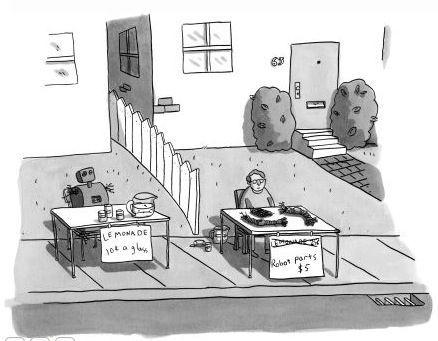How will the business model of humans change once robots do their job? The Technium proposes proposes The 7 Stages of Robot Replacement

University of Canterbury, New Zealand
How will the business model of humans change once robots do their job? The Technium proposes proposes The 7 Stages of Robot Replacement

Entertainment Computing (ENTCOM) Editors-in-Chief Ryohei Nakatsu and Matthias Rauterberg, and the Publisher Elsevier are pleased to announce an open Call for Papers authored by Young Investigators.
See at http://www.elsevierscitech.com/lmfile/otherformat/ENTCOM_YI.pdf
Our aim is to recognize early career academics working in the fields of digital entertainment, serious games, new media, entertainment computing, gaming, robotics, toys, and interactive art. All submissions will be vetted by the Editors-in-Chief, and only journal quality papers will be considered for further evaluation. Works should be interesting and novel. The top papers will appear in a forthcoming special issue of ENTCOM.
A cash prize of 1000 Euros and plaque will be awarded to the corresponding author of the best paper. Continue reading “Young Investigators Award: Call for Papers”
Okay, the recent news about the velocity of neutrinos is potentially amazing. But how on earth do 117 (!) get to be author of the paper? Seriously, here they are:
OPERA Collaboraton: T. Adam, N. Agafonova, A. Aleksandrov, O. Altinok, P. Alvarez Sanchez, S. Aoki, A. Ariga, T. Ariga, D. Autiero, A. Badertscher, A. Ben Dhahbi, A. Bertolin, C. Bozza, T. Brugiére, F. Brunet, G. Brunetti, S. Buontempo, F. Cavanna, A. Cazes, L. Chaussard, M. Chernyavskiy, V. Chiarella, A. Chukanov, G. Colosimo, M. Crespi, N. D’Ambrosios, Y. Déclais, P. del Amo Sanchez, G. De Lellis, M. De Serio, F. Di Capua, F. Cavanna, A. Di Crescenzo, D. Di Ferdinando, N. Di Marco, S. Dmitrievsky, M. Dracos, D. Duchesneau, S. Dusini, J. Ebert, I. Eftimiopolous, O. Egorov, A. Ereditato, L.S. Esposito, J. Favier, T. Ferber, R.A. Fini, T. Fukuda, A. Garfagnini, G. Giacomelli, C. Girerd, M. Giorgini, M. Giovannozzi, J. Goldberga, C. Göllnitz, L. Goncharova, Y. Gornushkin, G. Grella, F. Griantia, E. Gschewentner, C. Guerin, A.M. Guler, C. Gustavino, K. Hamada, T. Hara, M. Hierholzer, A. Hollnagel, M. Ieva, H. Ishida, K. Ishiguro, K. Jakovcic, C. Jollet, M. Jones, F. Juget, M. Kamiscioglu, J. Kawada, S.H. Kim, M. Kimura, N. Kitagawa, B. Klicek, J. Knuesel, K. Kodama, M. Komatsu, U. Kose, I. Kreslo, C. Lazzaro, J. Lenkeit, A. Ljubicic, A. Longhin, A. Malgin, G. Mandrioli, J. Marteau, T. Matsuo, N. Mauri, A. Mazzoni, E. Medinaceli, j, F. Meisel, A. Meregaglia, P. Migliozzi, S. Mikado, D. Missiaen, K. Morishima, U. Moser, M.T. Muciaccia, N. Naganawa, T. Naka, M. Nakamura, T. Nakano, Y. Nakatsuka, D. Naumov, V. Nikitina, S. Ogawa, N. Okateva, A. Olchevsky, O. Palamara, A. Paoloni, B.D. Park, I.G. Park, A. Pastore, L. Patrizii, E. Pennacchio, H. Pessard, C. Pistillo, N. Polukhina, M. Pozzato, K. Pretzl, F. Pupilli, R. Rescigno, T. Roganova, H. Rokujo, G. Rosa, I. Rostovtseva, A. Rubbia, A. Russo, O. Sato, Y. Sato, A. Schembri, J. Schuler, L. Scotto Lavina, J. Serrano, A. Sheshukov, H. Shibuya, G. Shoziyoev, S. Simone, M. Sioli, C. Sirignano, G. Sirri, J.S. Song, M. Spinetti, N. Starkov, M. Stellacci, M. Stipcevic, T. Strauss, P. Strolin, S. Takahashi, M. Tenti, F. Terranova, I. Tezuka, V. Tioukov, P. Tolun, T. Tran, S. Tufanli, P. Vilain, M. Vladimirov, L. Votano, J.-L. Vuilleumier, G. Wilquet, B. Wonsak, J. Wurtz, C.S. Yoon, J. Yoshida, Y. Zaitsev, S. Zemskova, A. Zghiche
If you ever wondered what my research focus is, well, here it is:
The HIT Lab NZ at the Canterbury University (Christchurch, New Zealand) has the following vacancy for a PhD student:
Robots that interact with humans are becoming increasingly important in our society. However, their life-like appearance and behavior is challenging their acceptance. In this project will establish new fundamental understanding of the role that anthropomorphism and animacy play in the behavior of robots when interacting with users. Methods will include the design, implementation and evaluation of a computational model of anthropomorphism and animacy in a robot. This model will enable robots to adapt their behavior to the user at an adequate level of perceived anthropomorphism and animacy, similar to the way adults adapt their behavior when interacting with children. Research outcomes will demonstrate how robots can match their interaction behavior with their abilities to perform tasks. Continue reading “PhD opening in Human Robot Interaction”